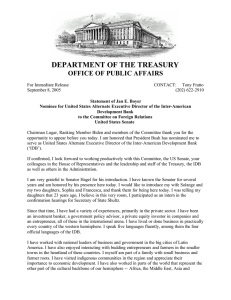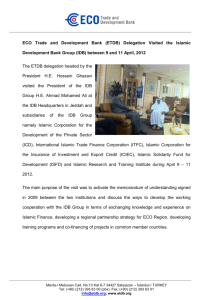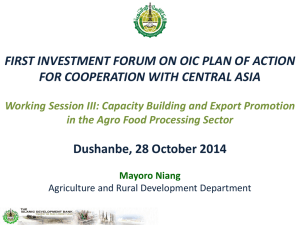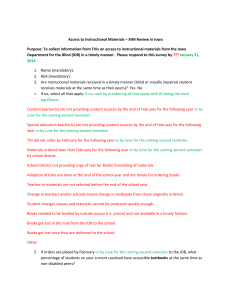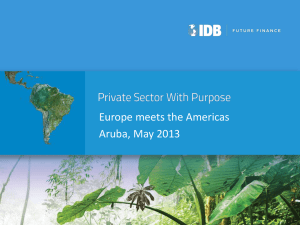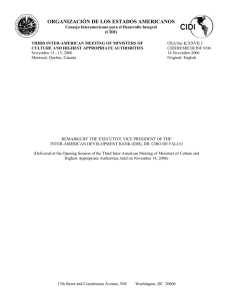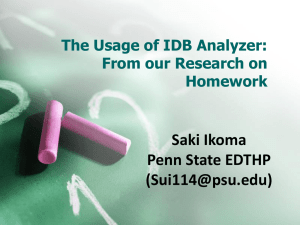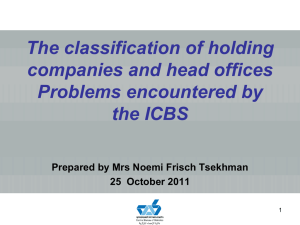A NEW ERA AT THE INTER-AMERICAN DEVELOPMENT BANK SIX RECOMMENDATIONS
advertisement
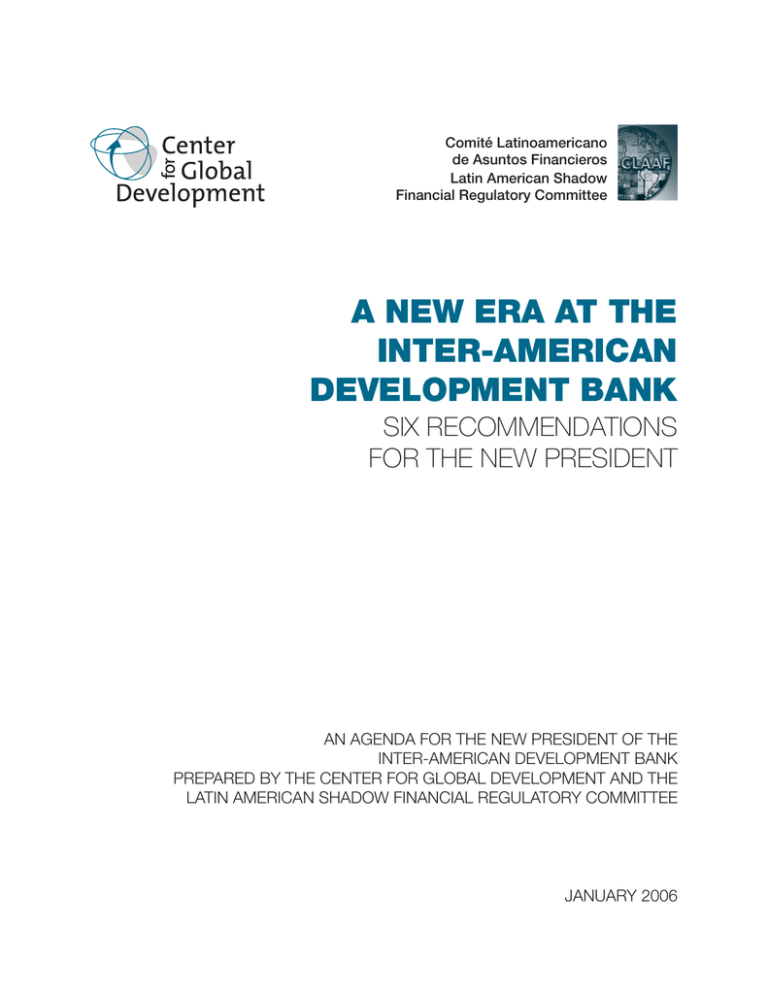
Comité Latinoamericano de Asuntos Financieros Latin American Shadow Financial Regulatory Committee A NEW ERA AT THE INTER-AMERICAN DEVELOPMENT BANK SIX RECOMMENDATIONS FOR THE NEW PRESIDENT AN AGENDA FOR THE NEW PRESIDENT OF THE INTER-AMERICAN DEVELOPMENT BANK PREPARED BY THE CENTER FOR GLOBAL DEVELOPMENT AND THE LATIN AMERICAN SHADOW FINANCIAL REGULATORY COMMITTEE JANUARY 2006 Comité Latinoamericano de Asuntos Financieros Latin American Shadow Financial Regulatory Committee A NEW ERA AT THE INTER-AMERICAN DEVELOPMENT BANK SIX RECOMMENDATIONS FOR THE NEW PRESIDENT THIS REPORT WAS PREPARED BY MEMBERS OF THE LATIN AMERICAN SHADOW FINANCIAL REGULATORY COMMITTEE AND STAFF OF THE CENTER FOR GLOBAL DEVELOPMENT JANUARY 2006 Copyright ©2006 by the Center for Global Development ISBN 1-933286-08-3 Center for Global Development 1776 Massachusetts Avenue, N.W. Third Floor Washington, D.C. 20036 Tel: 202 416 0700 Web: www.cgdev.org Members of the Working Group Nancy Birdsall President, Center for Global Development; Former Executive Vice-President, Inter-American Development Bank Pedro Carvalho de Mello*, Former Commissioner of the Securities and Exchange Commission, Brazil Guillermo O. Chapman Jr.* Former Minister of Planning and Economic Policy, Panama Claudio R. Contador* Managing Director of the National School of Insurance Foundation (Funenseg), Brazil Roque Benjamín Fernández* Former Minister of Finance, Argentina Pablo Guidotti* Former Vice-Minister of Finance, Argentina Angel Gurría* Incoming Secretary, Organisation for Economic Co-operation and Development; Former Minister of Finance and Public Credit, Mexico Ricardo Hausmann* Former Chief Economist, Inter-American Development Bank Ruth de Krivoy* Former President, Central Bank of Venezuela Guillermo Le Fort Former Executive Director, International Monetary Fund Liliana Rojas-Suarez* CLAAF Chair and Senior Fellow, Center for Global Development; Former Managing Director, Deutsche Bank Ernesto Talvi* Former Chief Economist, Central Bank of Uruguay Roberto Zahler* Former President, Central Bank of Chile This report was prepared for the new president of the Inter-American Development Bank by a working group comprising members of the Latin American Shadow Financial Regulatory Committee (CLAAF) and staff of the Center for Global Development (CGD). The working group members are grateful to Liliana Rojas-Suarez for her leadership of this project and to Guillermo Le Fort for an initial draft of the report. The report was made possible by generous support from the John D. and Catherine T. MacArthur Foundation, the Open Society Institute, and FELABAN (Federación Latinoamericana de Bancos). The views expressed are those of the authors. * Member of CLAAF Contents Key challenges in the new era 2 Strengths for confronting these challenges 2 Two cross-cutting themes: Flexibility and enhanced support for marketled growth 3 Six recommendations for the new president 4 1. Support policy and institutional reform 4 2. Expand and modernize private sector operations 5 3. Help members deal with exchange rate and other risks, in part through actively managing IDB liabilities 6 4. Obtain a clear mandate with adequate financing for a serious regional integration program 8 5. Fully realize the IDB’s potential as a regional knowledge bank 6. Get a mandate to help shape a new international financial architecture 10 References 12 Biographies of the contributors 13 9 ow should the Inter-American Development Bank (IDB) respond to the challenges of the new century? As recently as the early 1990s governments and policymakers in Latin America and the Caribbean relied on the IDB and other multilateral institutions not only as important sources of finance but also for ideas and technical assistance in designing economic policies. Partly as a result of this advice, many countries implemented wide-ranging market-oriented reforms to accelerate their integration into the world economy. But the perception grew that the agenda advised by Washington and the multilaterals did not represent the interests of the region. The failure of the reforms to fully satisfy expectations for more rapid growth and poverty reduction heightened tensions. Meanwhile, countries developed stronger local economic expertise, vastly improving the quality of the domestic policy debate. As a result, the market for the IDB’s services has changed dramatically. Rapid growth in private capital flows has made its financial resources less important than in the past. And political leaders are increasingly articulating their own vision on how to bring about inclusive growth in Latin America and the Caribbean, thereby reducing their need for advice from Washington. Yet the region is struggling with complex economic challenges that cannot adequately be addressed by individual nations or regional groupings, such as the Organization of American States. And there is no shortage of problems to be solved. The IDB’s mission of promoting inclusive growth is closely aligned with the region’s most pressing needs. The selection of a new president to lead the IDB presents an opportunity for the institution to reassess its role and reshape its products and services to better address current challenges. In response to this opportunity, the Latin American Shadow Financial Regulatory Committee and the Center for Global Development prepared this report for Luis Alberto Moreno, the new president of the IDB. This report lays out key challenges facing the institution, explains how the IDB is uniquely poised to address them, and offers six recommendations for the new president to consider as he launches what can and should be a new era at the IDB.1 H 1. A thoughtful series of internal and external reports produced over the past few years has raised important issues and challenges for the IDB, thus creating a blueprint for change that has been discussed at various levels among the shareholders. See, for instance, External Advisory Group (2002); IDB Office of Evaluation and Oversight (2004); and Gurría and Volcker (2001). 1 2 A New Era at the Inter-American Development Bank Key challenges in the new era Any effort to reinvigorate the IDB must confront serious risks and challenges Fortunately, the IDB also has key strengths for confronting these challenges Any effort to reinvigorate the IDB must confront serious risks and challenges. • The IDB’s relevance among middle-income countries is at risk. With highly cyclical external conditions, important segments of the membership with access to capital markets no longer require IDB financing in good times, while the assistance needed in times of difficulty far exceeds the IDB’s capacity. • The IDB might encounter significant difficulty meeting future demands. As significant global imbalances persist, the region may once again be heading for stormy waters, where external conditions become adverse and access to financial markets restricted. These conditions may impose important demands on the IDB, and it is unclear whether resources and programs needed to respond are sufficient. • Tension is rising over the market-driven development model, as greater ideological divisions begin to spill into the economic policy discussion. In part, this reflects the rising frustration with ongoing reforms, as growth has been disappointing even when global conditions were very favorable. And there is rising impatience with corruption and injustice. Unfortunately, justifiable demands are creating risks for future development—and for democracy itself—as voters are seduced by easy populist answers. • Long-standing political pressures and bureaucratic traditions may undermine the IDB’s effectiveness. For example, pressure on the president to satisfy various shareholders through senior appointments is not always conducive to excellence and divides the IDB into informal nationality fiefdoms. Strengths for confronting these challenges Fortunately, the IDB also has key strengths for confronting these challenges. • A solid sense of regional ownership. Compared with other multilateral institutions, the IDB has a more transparent and inclusive procedure for selecting its president, giving it far better governance credentials, contributing to a strong sense of regional ownership, and reinforcing its credibility with its membership. • A uniquely effective regional forum. The IDB is one of the few international settings where the single largest shareholder and the regional borrowers have a long history of practical cooperation on economic matters. • A strong record of promoting regional integration and supporting subregional institutions. Integration and capacity building contribute to improving Latin America and the Caribbean’s competitiveness in the global economy. 3 Six Recommendations for the New President • Wide potential for expanding private sector operations. Unlike the situation of the World Bank, IDB lending does not require a guarantee by a sovereign borrowing member. Thus the IDB has no restriction on lending directly to the private sector and other nonsovereign entities. It is free to lend to subsovereigns and subregional entities such as the Central American Development Bank (CABEI) and can pursue innovative, catalytic approaches to private sector development. • Skilled and knowledgeable staff. Personnel provide a strong human capital base with unique regional expertise, reflecting the extraordinary depth and breadth of professional expertise in the Latin America and Caribbean region. Two cross-cutting themes: Flexibility and enhanced support for market-led growth Articulating countries’ reform programs is a complex process, and the diversity of views and needs in the region is significant. More mature domestic policy discussions, the desire for ownership, and the recognition of diversity all challenge the IDB to remain relevant in its policy advice as its financing capacity shrinks in relation to private capital flows. In this challenging new environment, two themes cut across all recommendations: becoming more flexible in the products and services that the IDB offers and enhancing support for reforms that facilitate market-led growth. Flexibility is crucial because the region is part of a global economy that will continue to change rapidly—sometimes in ways difficult to predict. Given its comparative advantage in terms of ownership by the region, the IDB is uniquely positioned to respond actively and effectively to the diverse and evolving needs of Latin American and Caribbean economies. It should define its tasks like a club in which its members continuously review their priorities, identifying the needs of the region and building up the necessary resources and capacities for an effective response. Moreover, and as indicated throughout this report, the IDB’s commitment to flexibility should also be reflected in its reliance on risk management practices based on financial soundness indicators rather than artificial quantitative limits. It is also crucial that the IDB build upon its efforts to support members in designing and implementing market-oriented reforms that encourage private investment and increase competitiveness. Differences among countries notwithstanding, the most important obstacles to growth in the region are market failures, lack of know-how, and inadequate policies rather than lack of capital (box 1). The IDB should continue to support reforms that promote open, market-driven economies in which the private sector, especially the domestic private sector, is the engine of growth. A primary focus should be the use of the IDB’s resources and advice to help improve the environment for private investment, both domestic and foreign. At the same time, it should encourage and support public sector Flexibility is crucial because the region is part of a global economy that will continue to change rapidly—sometimes in ways difficult to predict It is also crucial that the IDB build upon its efforts to support members in designing and implementing market-oriented reforms that encourage private investment and increase competitiveness 4 A New Era at the Inter-American Development Bank Box 1 The region’s competitiveness is undermined by inadequate infrastructure, education, and governance and by inefficient labor markets The IDB and the region’s poorest countries In contrast to middle-income countries, the poorer countries in Latin America and the Caribbean generally face severe constraints in terms of their access to the international capital markets. The poorest countries that borrow from the soft window of the IDB and “low middle-income” countries such as Ecuador, Guatemala, and Paraguay face the same challenges and problems with which this report deals, including social gaps, fragile political and economic institutions, weak local capital markets, and vulnerability to volatile global financial markets. In addition, they need more access to finance to increase the pace of development investment while maintaining fiscal discipline. The role of the IDB in these countries is not to become another aid agency, but instead to exploit its comparative advantages to the fullest by providing adequate policy advice and, to the extent possible, soft lending financing. efforts to pursue social policies that increase the inclusiveness of the growth process. Six recommendations for the new president To respond flexibly to global conditions while helping governments design and implement market-oriented policies that foster inclusive growth, the IDB must address six issues that currently hinder its performance. We recommend that the president consider our recommendations for these six issues as the basis for a medium-term strategic plan for a new era at the IDB. 1. Support policy and institutional reform In an increasingly integrated global economy the need to remain competitive is essential. Growth in Latin America and the Caribbean is constrained by loss of competitiveness relative to both rich countries and other developing regions, particularly Asia.2 The region’s competitiveness is undermined by inadequate infrastructure, education, and governance and by inefficient labor markets. In addressing these problems the IDB is engaging in dialogue with member countries to improve policy implementation and to strengthen competitiveness programs. In addition, it is supporting the capacity building of the region’s public institutions, which entails working with parliaments, the judiciary, and local governments. Increasing competitiveness requires sound policies and stronger institutions, and the IDB is already helping to finance efforts to address both needs. In this regard, policy-based loans have been an important tool, providing flexible support for institutional and policy changes. 2. We endorse the views on national competitiveness as a basic tool for development expressed in the report of the IDB External Advisory Group (2002). 5 Six Recommendations for the New President To more effectively finance policy and institutional reform, we recommend: • Removing restrictions that allow no more than $4.5 billion of Ordinary Capital resources and $300 million of Fund for Special Operations resources to be used for policy-based loans. Removing these restrictions would increase the IDB’s flexibility in carrying out its operations. To better support institutional and policy reforms, policy-based loans should become a regular and fully accepted IDB product.3 • Creating a hassle-free loan to support the strategies of countries well along in the reform process. Unlike policy-based loans and other IDB products, this instrument would be available only to countries that prequalify by meeting specific standards, such as protection of the environment, safeguards in procurement, and fiscal transparency. Countries that qualify would access the line up to authorized limits while avoiding the hassle associated with disbursing regular loans. After disbursement, the borrower would be required to maintain the agreed standards and be subject to an annual review.4 • Providing countercyclical emergency loans using the IDB’s facilities, subject to the various conditions that justify its participation in International Monetary Fund–led programs. Participation in emergency financing should be carried with the IDB’s own conditionality, so that its capital is used to attain its own goals. One possibility is to offer prequalified countries a line of credit with traditional maturity of five to seven years to support public sector financing. Prequalification could be based on standards similar to those applying to the new hassle-free loans proposed above. Additional recommendations to help countries during volatile periods are contained in recommendation 6 below. 2. Expand and modernize private sector operations Achieving market-led growth in Latin America and the Caribbean requires a pivotal role for the private sector. However, many factors hinder the funding of private projects in the region, including: the presence of market failures that inhibit investment and innovation, the continuing large involvement of the state in fundamentally private productive and financial activities, the persistence of regulatory and legal problems, and deficiencies in corporate governance. All these factors constrain the development of financial markets. Given that the IDB has no restrictions on lending to the private sector and subsovereign entities, such as municipalities, it is time to expand and modernize its private sector lending and to more aggressively explore the potential for direct lending to subsovereigns.5 The IDB’s initiatives toward the solution of these problems are evidenced in the activities of its three windows of private sector finance 3. This recommendation is similar to one in IDB External Advisory Group (2002, section V.5). 4. See Birdsall and Kapur (2005) for further details on the functioning of this type of instrument. 5. Elsewhere we discuss mechanisms by which the IDB could minimize the foreign exchange risk subsovereigns would assume. We recommend removing restrictions on the use of IDB resources for policybased loans Create a hassle-free loan for countries well along in the reform process 6 A New Era at the Inter-American Development Bank Table 1 Functions of the three windows of IDB private sector finance Private Sector Department Inter-American Investment Corporation Multilateral Investment Fund On the IDB balance sheet ($40 billion of capital) it lends to private agents (providing no more than 25 percent of the total lending) primarily in support of private investment in infrastructure and the development of domestic capital markets. With its own balance sheet (about $0.5 billion in assets) it provides loans and equity in support of expansion and modernization of the small and medium enterprise sector. These activities are conducted with its own funds and instruments or in association with other lenders or investors. A $1.2 billion grant facility funded by contributions from member governments, this trust fund uses grants and equity investments to demonstrate new ways to develop micro and small enterprise, build worker skills, strengthen environmental management, and improve the functioning of financial and other markets. (table 1). Each of these windows is making an important contribution, yet much more is still needed. In particular, the portion of the IDB’s balance sheet associated with the private sector is still insignificant, currently at about 4 percent of loans. Moreover, the IDB finds it difficult to compete against other sources of private funding because its efforts to provide services to the private sector are segmented and poorly coordinated. To more effectively support the private sector and nonsovereigns, we recommend: • Removing the present quantitative restriction on IDB lending to the private sector and to other nonsovereign entities (that private sector assets not exceed 10 percent of total IDB outstanding assets).6 • Commissioning, by the president, an independent survey of the costs and bureaucratic obstacles of doing business with the private sector window of the IDB. Potential measures to reduce costs and delays in this window should also be assessed. In addition, the survey should address potential overlaps, gaps, or inefficiencies derived from the existence of three different windows with related functions. The results of the survey should be publicly available. • Considering of a strategy for establishing country-based institutions that would work with firms in the development and diffusion of technologies. IDB support for research and development should be conditional on the widespread availability of the innovations as regional public goods. Furthermore, the IDB could establish a system of rewards for transforming ideas and scientific findings into practical solutions. 3. Help members deal with exchange rate and other risks, in part through actively managing IDB liabilities Many governments and firms in Latin America and the Caribbean confront significant exchange rate risk due to a sizeable currency mismatch in their balance sheets. The roots of the problem are the limited development of long-term financing denominated in domestic currencies and, in parallel, 6. Although the restriction is currently not binding, it sends the wrong signals about the scope of the IDB’s future involvement with the private sector. 7 Six Recommendations for the New President the missing markets for instruments to hedge currency risk.7 This risk exposure is aggravated by volatile external conditions that are reflected over time in significant changes in real exchange rates. The IDB has traditionally used only the asset side of its balance sheet through its lending operations, while the liability side has been passively managed with the single goal of minimizing the costs of raising financing in the international capital markets. The region would benefit if the IDB devised ways to actively manage its liabilities in order to complete markets. This could be achieved by helping to price risk, disseminating information about local currencies, and supporting the development of hedging markets and regional commodity and futures exchanges. In helping members to deal with exchange rate and other external risks, we recommend: • Issuing in the international capital markets, long-term AAA bonds in local currencies or indexed to domestic price indices—and for different maturities. This could help to create a benchmark yield curve and to develop hedging instruments. For example, IDB bonds with AAA rating issued under New York law would make it possible to separate currency risk from sovereign and convertibility risks. The bonds in domestic currency, nominal or real (CPI indexed), could be used to provide insurance against exchange rate risk. Issuing domestic currency bonds would not necessarily imply that the IDB takes exchange risk into its balance sheet; the IDB could either lend in domestic currency the amount raised in local currency bonds or offer medium- and long-term cross-currency swaps.8 • Exploring, together with members, the benefits of developing markets for bonds indexed to a variety of variables including, for instance, commodity prices or U.S. economic growth. These instruments would be useful in dealing with risks such as terms of trade and external demand volatility, where hedging instruments need to be developed. When appropriate, the IDB could also help members to design such instruments. • Exploring the provision of public sector credit guarantees denominated in the region’s local currencies.9 This would help sovereign issuers in one country gain access to capital markets of other countries within the region. These guarantees could also help promote the securitization of public sector assets and deepen the integration and size of regional capital markets. 7. It is important to note, however, that not all countries are in a position to issue debt in their own currency for all maturities because market perceptions on macroeconomic risk would result in prohibitively high borrowing costs. In this case, it is more reasonable to focus efforts on reducing exchange rate risk. 8. Lending would contribute directly to improving the structure of risks among its debtors. In offering currency swaps, the IDB would cover the exchange risk arising from borrowing in local currencies by offering medium- and long-term currency swaps that would convert the financing back to dollars. This operation would allow local debtors to convert their dollar liabilities into domestic currency liabilities, thus encouraging the development of a market for hedging exchange risk. 9. This is in line with the recommendation made in IDB External Advisory Group (2002). The IDB should explore the provision of public sector credit guarantees denominated in the region’s local currencies 8 A New Era at the Inter-American Development Bank The president needs to obtain from the shareholders a new mandate and the approval for the allocation of significant additional resources to fully implement a serious and comprehensive integration program 4. Obtain a clear mandate with adequate financing for a serious regional integration program Regional integration in Latin America and the Caribbean, particularly of energy and transportation systems, is extremely poor and undermines the region’s competitiveness in the global economy. Political risks, including lack of a shared regulatory framework, discourage investment in regional infrastructure, forestalling projects that would otherwise contribute to higher growth. Regional integration in areas other than infrastructure, such as trade and finance, also suffers from important weaknesses. The IDB can help to address these problems by creating a serious and comprehensive regional integration program. The president needs to obtain from the shareholders both a new, clear mandate and the approval for the allocation of significant additional resources to fully implement such a program. To carry out the mandate for regional integration, we recommend the establishment of new and creative instruments, including: • New loan and guarantee products for multicountry investments by borrowers. These new instruments could take a number of forms. The IDB could offer political insurance to potential investors in multicountry projects, while using its leverage to strengthen international cooperation among governments in order to reduce the cost of the guarantees. Or it could establish multilateral facilities similar to those extended by the Corporación Andina de Fomento and the Banco Centro-Americano de Integración Economica, using regional funding for regional development that creates an enhanced feeling of ownership. One possibility is to establish facilities funded by the same members that are the beneficiaries of the loans to finance regional infrastructure. This highly flexible instrument allows countries to make multiyear commitments for joint infrastructure projects minimizing the individual political risk associated, for instance, with the change of government in one of the countries involved. This type of facility could be also used to fund and coordinate multicountry infrastructure projects that are desirable from a regional perspective but where the benefits may not accrue directly to the country where be investment is made (for instance, construction of a road that provides ocean access for country A in country B but passes through country C). • A regional fund directed at supporting integration, at least partly through grants.10 Contributions to the fund could come in equal parts from nonborrowers and from an annual allocation of net income from lending operations or income from interest on IDB capital. The fund could operate like a trust fund, with shared governance between contributors, major borrowers, and the low-income countries that are beneficiaries of the Fund for Special Operations.11 10. The size of the fund needs to be significantly large to be relevant. For example, the fund could accumulate between $1 billion and $2 billion in a five-year period. 11. A similar proposal can be found in Birdsall and Kapur (2005). 9 Six Recommendations for the New President The argument for using grants is to avoid coordination problems associated with attributing the cost of loans to different borrowers (which the above proposals for new approaches are meant to minimize in the case of large infrastructure projects). The resources from the fund could finance regional programs, including the coordination of efforts to prevent diseases and plagues following the recommendations of international sanitation bodies. Fund resources could also finance technical assistance to upgrade and subsequently integrate national payments systems to reduce multicountry transaction costs. 5. Fully realize the IDB’s potential as a regional knowledge bank Among the key challenges facing the IDB is finding ways to assist governments in channeling a large variety of public demands into policy responses that are conducive to growth, reduced corruption, and improved equity. Achieving this goal requires making excellent performance the sole criterion for staff appointments at all levels. It is reasonable to expect that over time staff composition will reflect the large number of IDB member countries. However, members—both borrowers and nonborrowers—have traditionally put pressure on the president to make specific senior appointments from specific countries. Fortunately, in this regard the IDB has been moving in the right direction during the last 15 years: there has been an increasing emphasis on merit and transparency in personnel choices at working levels. We are further encouraged by the new president’s most recent senior appointments, which appear to be based on relevant experience and expertise while still achieving adequate balance among nationalities. The IDB cannot fully exploit its highly qualified human capital base unless certain deficiencies in the current organizational structure are removed. For example, borrowers would benefit from further reallocation of economists and technical experts to country offices, since this deepens dialogue and increases staff understanding of local country constraints.12 In addition, specialists with similar expertise are spread across different departments, inhibiting the creation of a critical mass that facilitates institutional learning. While there is no such a thing as an ideal organizational structure, we applaud the new president’s initiative to revisit the current structure in the light of new challenges and opportunities. To serve more effectively as a knowledge bank, the IDB needs to consider: • Strengthening the role of the research department in shaping the IDB’s position on the most imperative issues of the region. More broadly, the chief economist and head of the research department should assist the IDB’s leadership in developing a strategy to achieve 12. There is evidence that this approach has yielded positive results in the World Bank during the last decade. Make excellent performance the sole criterion for staff appointments at all levels The IDB cannot fully exploit its highly qualified human capital base unless important deficiencies in the current organizational structure are corrected 10 A New Era at the Inter-American Development Bank To help countries cope with global volatility, the IDB should be the region’s voice in promoting and implementing the reform of the international financial architecture inclusive growth in Latin America and the Caribbean. This role is especially important given our recommendation below that the president seek a mandate for a greater role for the IDB in central matters regarding the international financial architecture. • Charging for technical assistance services. The benefits of having every specialized technical unit selling its expertise to member countries are twofold. First, introducing market discipline in the provision of these services would provide valuable information regarding the real demand for them. Second, charging for technical assistance would eliminate the need to recover costs from lending operation net income, thus reducing pressure to lend merely to increase net income. • Establishing in partnership with borrowers (for example, with combined IDB and borrower financing) specialized regional institutes or centers to generate and preserve technical knowledge where members need continued assistance. Examples of such specialized knowledge include health, education, environment, debt management, trade negotiations, tax systems and administration, and auditing and procurement, among others. These centers of regional expertise could help to shape IDB projects and programs.13 They should be ready to work with all levels of national and subnational governments. Specialized regional centers would strengthen the IDB’s authority in regional policy debates and contribute to building stronger links and exchange of experiences among member country governments and the private sector, as well as with other multilateral institutions. 6. Get a mandate to help shape a new international financial architecture International capital flows have become central to the international environment faced by Latin American and Caribbean economies—and most of them have already suffered volatility in external financing at one time or another. Even those countries carrying out prudent policies have been severely affected by capital flow volatility through contagion. External volatility reduces the effectiveness of reforms and the capacity to finance the inclusive social programs central to poverty reduction (and critical to meeting the Millennium Development Goals). Thus, a central challenge for the IDB is to help countries cope with the volatile international financial environment by providing limited emergency financing (see the discussion under recommendation 1). More important, it can serve as the region’s voice in promoting and implementing the reform of the international financial architecture. To contribute to shaping the reform of the international financial architecture, we recommend that: • The IDB president obtain a mandate from the shareholders for active participation in all international forums where various aspects of the 13. These centers and their funding need to be part of the comprehensive regional integration program discussed in recommendation 4. 11 Six Recommendations for the New President international financial architecture are debated. Among other steps, the president should formally request that the IDB become a full member of the International Monetary and Financial Committee and the World Bank Development Committee.14 The IDB should also participate in other relevant discussions, be those at the Bank for International Settlements, the Basel Committee, the Financial Stability Forum or in G-8 and G-20 discussions of the international financial architecture. With the support of the board, the president and staff should provide an independent view that reflects the interests of Latin American and Caribbean countries and is directed at modifying the international financial architecture so as to mitigate the risks of contagion and attain a more stable financial environment. • The IDB take leadership in ensuring collaboration with the International Monetary Fund and the World Bank in designing proposals to reduce financial contagion. One proposal worth exploring refers to a facility directed at limiting the contagion effects of external crisis by smoothing out the value of an index of bond prices of emerging markets countries that have met certain prequalifying criteria similar to the now-defunct Contingent Credit Line of the International Monetary Fund.15 The intervention would consist of swapping the emerging market bonds in the index for U.S. Treasury bills whenever bond prices move out of a certain band.16 Other possible instruments for supporting debtor countries include the recently proposed Stability and Growth Facility to support highly indebted middle-income countries that meet basic conditionality on macroeconomic stability and social targets, with subsidized loans from the International Monetary Fund or World Bank. The IDB could also participate in this financing with approval of its members.17 • The IDB president put back in the international agenda the discussion on the desirability of agreeing on an explicit set of rules for sovereign debt restructuring.18 Recent experiences in the region show that a long period of difficulties and uncertainties result after a sovereign default. A more expeditious resolution would require that failed debtors have incentives to comply with the set rules, under the expectation that this behavior would result in access to external financing at lower cost. Similarly, the IDB should assist member countries in upgrading national bankruptcy rules so as to meet international standards. 14. The United Nations Development Programme has recently become a full member. Regional development banks are currently “observers.” 15. See International Monetary Fund (2004). 16. The operational details and funding of this facility should be defined in the international discussion to reform the international financial architecture. 17. Dervis and Birdsall (forthcoming) propose this concessional facility to help high-debt countries reduce their debt, maintain a sound fiscal stance and move more rapidly toward achieving the Millennium Development Goals. See Forbes (forthcoming) for a discussion of sovereign issues linked to commodity prices and other uncertain factors. 18. See International Monetary Fund (2002). Obtain a mandate from the shareholders for active IDB participation in all international forums where the international financial architecture is debated References Birdsall, N., and D. Kapur. 2005. The Hardest Job in the World: Five Crucial Tasks for the President of the World Bank. Washington, D.C.: Center for Global Development. Dervis, K., and N. Birdsall. Forthcoming. “A Stability and Social Investment Facility.” In E. Truman, ed., Reforming the IMF for the 21st Century. Washington, D.C.: Institute for International Economics. [www.cgdev.org/content/publications/detail/5853]. Forbes, K. Forthcoming. “A Shock-Smoothing Facility (SSF) for the IMF.” In E. Truman, ed., Reforming the IMF for the 21st Century. Washington, D.C.: Institute for International Economics. Gurría, A., and P. Volcker. 2001. “The Role of Multilateral Development Banks in Emerging Market Economies.” Carnegie Endowment for International Peace, Washington, D.C. IADB External Advisory Group. 2002. “The Challenge of Being Relevant: The New Role of the IADB.” Report to the President of the IADB. Washington, D.C. IADB Office of Evaluation and Oversight. 2004. “Instruments and Development: An Evaluation of IADB Lending Modalities.” Washington, D.C. IMF (International Monetary Fund). 2002. “The Proposed Features of a Sovereign Debt Restructuring Mechanism.” Staff paper presented to the Board of the IMF. Washington, D.C. ———. 2004. “Fact Sheet: The Contingent Credit Line (CCL).” Staff paper presented to the Board of the IMF. Washington, D.C. 12 Biographies of the contributors Nancy Birdsall Nancy Birdsall is the Founding President of the Center for Global Development. She served for three years as Senior Associate and Director of the Economic Reform Project at the Carnegie Endowment for International Peace. Her work there focused on issues of globalization and inequality, as well as on the reform of the international financial institutions. From 1993 to 1998 she was Executive Vice-President of the Inter-American Development Bank, the largest of the regional development banks, where she oversaw a $30 billion public and private loan portfolio. Before joining the Inter-American Development Bank, she spent 14 years in research, policy, and management positions at the World Bank, most recently as Director of the Policy Research Department. Ms. Birdsall is the author, co-author, or editor of more than a dozen books and monographs. She has also written more than 75 articles for books and scholarly journals published in English and Spanish. Shorter pieces of her writing have appeared in dozens of U.S. and Latin American newspapers and periodicals. Pedro Carvalho de Mello Pedro Carvalho de Mello is Professor of Economics at the University of São Paulo’s Escola Superior de Agricultura. Previously, he held the posts of Senior Economist, Transportation and Regional Economics, at PLANAVE, Chief Economist and Research Director at the Brazilian Institute of Capital Markets, Commissioner at the Brazilian SEC, Vice President at PNC International Bank, and Director at the Commodities and Futures Exchange. He has also been Visiting Professor at Columbia University. He is the author of several books and articles, published in Brazil and abroad. Mr. Carvalho de Mello pursued graduate studies in Law in the State University of Rio de Janeiro and holds a Master’s and a Ph.D. in Economics from the University of Chicago. Guillermo O. Chapman Jr. Guillermo Chapman has served as Chairman of the Board and Chief Executive Officer of INDESA since 1999. From 1994 to 1998, he served as Minister of Planning and Economic Policy, Republic of Panama, where he implemented a modernization plan that included a general reduction of import duties, privatization of public services, restructuring and reduction of public debt, and modern legislation on banking and securities. From 1964 to 1968 he served as Special Ambassador to the United States, member of the Panama Negotiating Mission on the Canal Treaties. From 1961 to 1963 he was a member of the Staff to the President of Panama and previously held the position of Economist at the Ministry of Public 13 14 A New Era at the Inter-American Development Bank Works in Panama. From 1957 to 1958 he worked for Citibank in Panama and also held positions in Investment Banking in Central America. He has authored essays, articles and co-authored and edited several books. He serves on the Boards of Directors of several private corporations and is active in public affairs, civic groups, trade organizations and sports. Mr. Chapman holds Bachelor of Arts and Master of Arts degrees in Economics and Finance from Louisiana State University. Claudio R. Contador Claudio Contador serves as President of SILCON, Estudos Economicos Ltda., S/C, a consulting firm in Rio de Janeiro, Brazil. He is a member of the Audit Board of Universidade Santa Ursula, the Council of Economy, Politics, and Sociology of the Federação de Comércio do Estado de São Paulo, the Managing Director of the National School of Insurance Foundation— Funenseg, Forecaster for Latin America, Consensus Economics Inc., London. He is a also a member of the Technical Advisory Council of SR Rating/Duff & Phelps, Rio de Janeiro, the Latin-American Shadow Financial Regulatory Committee (LASFRC), and the Board of the National Confederation of Commerce, Rio de Janeiro. His teaching and research experience include different positions in the Getulio Vargas Foundation, the Research Institute (INPES/IPEA) of the Ministry of Planning, and the Federal University of Rio de Janeiro (COPPEAD). Previously, Mr. Contador served as coeditor of the quarterly bulletin Boletim Indicadores Antecedentes (Bulletin of Leading Indicators), and Director of the Graduate School of Business Administration, Federal University of Rio de Janeiro, and the Center for Research and Studies in Insurance (COPPEAD).His major areas of research include: Econometric models, strategy planning, simulation systems, insurance market, cost-benefit analysis, business cycles, leading indicators, and forecasting. He has published twelve books and more than 250 articles in Brazil and abroad. Mr. Contador holds a Ph.D. and a Master’s in Economics from the University of Chicago. Roque Benjamín Fernández Roque Fernández serves as Director of the Department of Accounting at Universidad del Centro de Estudios Macroeconómicos (UCEMA), where is Professor of Macroeconomics and International Finance. He is the President of the Board of Directors of Centro de Estudios Macroeconómicos de Argentina. He has held a number of positions in the Argentine Government, including Minister of Economy and Public Works and Services, and Director, Vice President, and President at the Central Bank of Argentina. He has also worked in different positions at the International Monetary Fund and the United Nations and as a consultant for the World Bank. He has held Professorships at the University of Chile, the National University of Córdoba, the University of Southern California, and Florida International University. Mr. Fernández is the author of Inflation and Stability: The Exchange Rate as a Stabilization Instrument and is the co-author of Growth and Freedom: 15 Six Recommendations for the New President Essays on Political Economy. He has also published many papers in highly prestigious reviews, newspapers and magazines. Mr. Fernández holds a Ph.D. in Economics from the University of Chicago and a degree of Doctor en Ciencias Económicas from the National University of Córdoba in Argentina. Pablo Guidotti Pablo Guidotti is Dean of the School of Government at Universidad Torcuato Di Tella, Counselor of Fundación Universidad Torcuato Di Tella, and member of the Latin American Shadow Financial Regulatory Committee. He served as Counselor at Instituto Torcuato Di Tella, Vice-President and Member of the Board of Directors, Caja de Valores, S.A., and CoChairman, G-22 Working Group on Strengthening Financial Systems. He held the positions of Deputy Minister of the Economy and Secretary of the Treasury of the Republic of Argentina, Vice-President and Member of the Board of Directors of the Central Bank of Argentina, Member of the Executive Board of the Trust Fund for Bank Capitalization, and Advisor to the President of the Central Bank of Argentina. He was Professor of Money and Banking at the University Torcuato Di Tella, Professor of Economics at the Centro de Estudios Macroeconómicos de Argentina. He also worked at the International Monetary Fund and University of Colorado, Boulder. Mr. Guidotti holds a Ph.D. in Economics from the University of Chicago. Angel Gurría José Angel Gurría has recently been named Secretary-General of the Organisation for Economic Co-operation and Development, starting June 1, 2006. He is the former Minister of Foreign Affairs and former Minister of Finance of Mexico and was a Mexican civil servant for 33 years. He headed Mexico’s foreign financing strategy in the late 1970s and early 1980s and Mexico’s debt restructuring negotiations during the late 1980s and early 1990s. He co-chaired the Commission on the Role of the MDBs in Emerging Markets in 2001 with Paul Volcker and chaired the External Advisory Group on the future of the Inter-American Development Bank. He is a member of the board of a number of nonprofit institutions, including the Center for Global Development, the Population Council, and the UN Secretary-General’s Advisory Board on Water. He is also a member of a number of Advisory Boards and Boards of Directors for private companies in Mexico, Spain, and the United States. Ricardo Hausmann Ricardo Hausmann is Director of Harvard’s Center for International Development and Professor of the Practice of Economic Development at Harvard University’s Kennedy School of Government. He served as the first Chief Economist of the Inter-American Development Bank, where he created the Research Department. He has served as Minister of Planning of Venezuela and was a member of the Board of the Central Bank of Venezuela. He also served as Chairman of the International Monetary Fund–World Bank Development Committee. He was Professor 16 A New Era at the Inter-American Development Bank of Economics at the Instituto de Estudios Superiores de Administración (IESA) in Caracas where he founded the Center for Public Policy. He was also a visiting fellow at Oxford University. His research interests include issues of growth, macroeconomic stability, international finance and the social dimensions of development. His recent books include Global Finance from a Latin American Viewpoint, Wanted: World Financial Stability, Democracy, Decentralization and Deficits in Latin America, Securing Stability and Growth in Latin America: Policy Issues and Prospects for Shock-Prone Economies, and Banking Crises in Latin America. He holds an M.A. and Ph.D. in Economics from Cornell University. Ruth de Krivoy Ruth de Krivoy currently serves as President of Síntesis Financiera, a financial consulting firm in Caracas, Venezuela. She is also an Advisor to the Financial Stability Institute (BIS) and Member of the Executive Board and Advisory Board on Banking of the Toronto International Leadership Centre in Financial Sector Supervision. Previously, she served as President of the Central Bank of Venezuela; member of Venezuelan official commissions on State Reform, Foreign Public Sector Debt Refinancing and Fiscal Reform; Chairperson of the Venezuelan Presidential Commission on Industrial Competitiveness; and member of numerous Venezuelan official and private sector international missions. She was Professor and Chair of the Department of Monetary Theory and Policy, Faculty of Economics at Central University of Venezuela. Mrs. de Krivoy authored papers on monetary and financial topics, and the book Collapse: The Venezuelan Banking Crisis of 1994. She earned her degree in Economics at Universidad Central de Venezuela. Guillermo Le Fort Guillermo Le Fort acted as the Executive Coordinator of the Working Group. He works currently as a consultant in Economic and Financial Matters based in Santiago. During his career he has been Executive Director at the International Monetary Fund representing the Southern Cone; Director of International Affairs and Deputy Director of Research at the Central Bank of Chile; Senior Economist and Resident Representative at the International Monetary Fund and professor of economics at the Universidad de Chile. He has published several articles in international macroeconomics and finance, and taught in several universities in Chile and the United States. He holds a Ph.D. in economics from UCLA and Magister and Licenciado degrees from Universidad de Chile. Liliana Rojas-Suárez (Chairperson of CLAAF) Liliana Rojas-Suarez is a Senior Fellow at the Center for Global Development and the Chair of the Latin American Shadow Financial Regulatory Committee. Previously, she served as Managing Director and Chief Economist for Latin America at Deutsche Bank and as the Principal Advisor in the Office of Chief Economist at the Inter-American Development 17 Six Recommendations for the New President Bank. She has also held various positions at the International Monetary Fund, most recently as Deputy Chief of the Capital Markets and Financial Studies Division of the Research Department. She has been a Visiting Fellow at the Institute for International Economics and has also served as a Professor at Anahuac University in Mexico and an Advisor for PEMEX, Mexico’s National Petroleum Company. She has also testified before a Joint Committee of the U.S. Senate on the issue of dollarization in Latin America. Ms. Rojas-Suarez has published widely in the areas of macroeconomic policy, international economics and financial markets. She holds a Ph.D. in Economics from the University of Western Ontario. Ernesto Talvi Dr. Ernesto Talvi is currently the Executive Director of CERES (Center for the Study of Economic and Social Affairs), an independent public policy research institution in Montevideo, Uruguay, specializing in the economic analysis of Latin American economies. He is also a permanent advisor to the Chief Economist of the Inter-American Development Bank (IADB), Dr. Guillermo Calvo, in charge of monitoring and analyzing regional economic developments in Latin America. He is a member of the Latin American Shadow Financial Regulatory Committee (CLAAF). He was Senior Research Economist at the Research Department of the IADB, Chief Economic Advisor of Uruguay’s Economic team, Chief Economist and Head of Research of the Central Bank of Uruguay, and member of the Executive Committee of LACEA (Latin American and the Caribbean Economic Association). He is a professor at Universidad ORT (Uruguay) and visiting professor at the Universidad Torcuatto di Tella (Argentina). He has published several academic and policy articles in books and journals and his areas of expertise include the macroeconomics of emerging markets, stabilization programs, fiscal policy, capital flows and financial crises. Mr. Talvi holds a Ph.D. in Economics and an MBA from the University of Chicago. Roberto Zahler Roberto Zahler is President of the consultancy firm Zahler & Co. and Chairman of Siemens-Chile. He is a member of the Latin American Shadow Financial Regulatory Committee (LASFRC) and of the Emerging Market Economies Eminent Persons Group (EMEEPG). He is also a member of the Board of such firms as Banco Santander-Chile and Deutsche Bank Americas Bond Fund. He was President of the Central Bank of Chile and a visiting scholar at the Research Department at the International Monetary Fund. He has held different positions at ECLAC and was a member of different international working groups, such as the International Monetary Fund Quota Formula Review Group. Mr. Zahler has given technical assistance to Central Bankers and Finance Ministers in a number of countries in Latin America and as been a consultant for the ECLAC, the International Monetary Fund, and the World Bank, among others. He is author of more than 90 publications and articles in books and international journals. He holds a Ph.D. (c) in Economics from the University of Chicago. A NEW ERA AT THE INTER-AMERICAN DEVELOPMENT BANK SIX RECOMMENDATIONS FOR THE NEW PRESIDENT PREPARED BY THE CENTER FOR GLOBAL DEVELOPMENT AND THE LATIN AMERICAN SHADOW FINANCIAL REGULATORY COMMITTEE CLAAF CHAIR Liliana Rojas-Suarez EXECUTIVE COORDINATOR Guillermo Le Fort REPRESENTATIVES OF CLAAF AND CGD Nancy Birdsall Pedro Carvalho de Mello Guillermo O. Chapman Jr. Claudio R. Contador Roque Benjamín Fernández Pablo Guidotti Angel Gurría Ricardo Hausmann Ruth de Krivoy Ernesto Talvi Roberto Zahler Copyright ©2006 by the Center for Global Development ISBN 1-933286-08-3 Center for Global Development 1776 Massachusetts Avenue, N.W. Third Floor Washington, D.C. 20036 Tel: 202 416 0700 Web: www.cgdev.org Designed, edited, and produced by Communications Development Incorporated, Washington, D.C.
